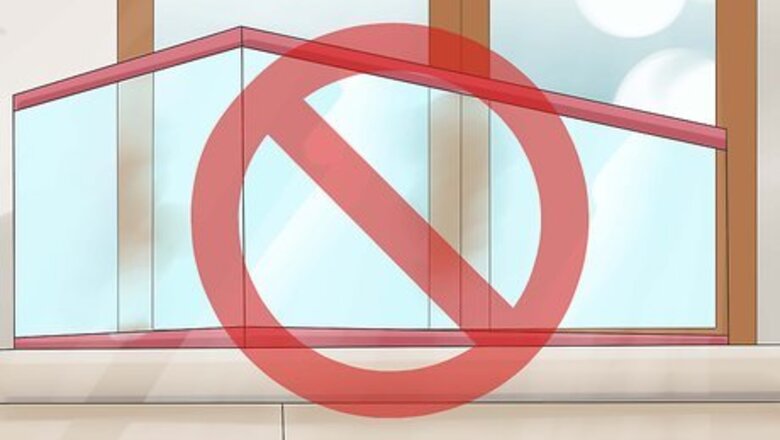
views
Setting Up the Aquarium
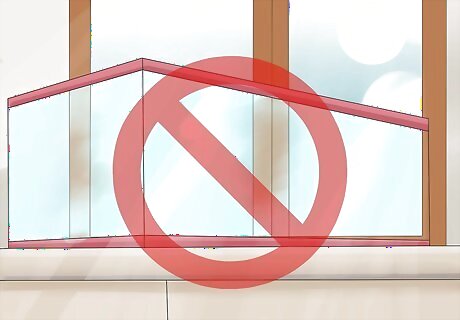
Choose the right location. When setting up your aquarium, you need to be sure to put it in a location that will be least stressful for your fish. Avoid locations that will expose the fish to loud noises, like near a TV or sound system or near a washer and dryer, etc. Avoid locations that will affect the temperature of the water, like near a heater, radiator, or cooling unit. Avoid locations where frequent vibrations with affect the fish, such as near frequently opening and closing doors or in high foot-traffic areas. Don’t place your aquarium under a direct natural light source, like a skylight or window, because it can increase algae production and throw off the balance of the tank’s ecosystem. Don't place your aquarium in a place where there could potentially be drafts, such as near windows and doors.
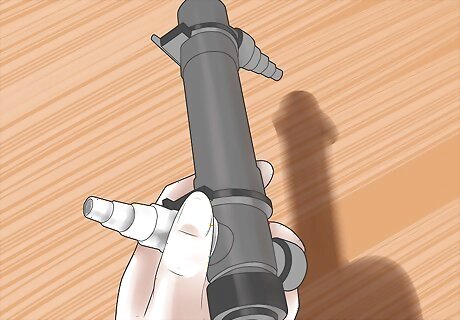
Install a high-quality filtration system. It’s nearly impossible to over-filter an aquarium, so err on the side of more rather than less filtration. There are three kinds of filtration, mechanical, biological, and chemical. Mechanical filtration uses a pump to draw water through a sponge, which will trap debris. Mechanical filtration helps keep the tank water looking clean and clear, though most tropical fish don’t require crystal-clear water for their habitat, so the clear water is mostly for your benefit. Biological filtration also draws water through a sponge, but in this case the sponge contains bacteria that remove pollutants. Chemical filtration uses a special filter media that removes chemical pollutants. If you have a saltwater tank, you’ll also need a protein skimmer, a filtration device that removes dissolved organics from the water.
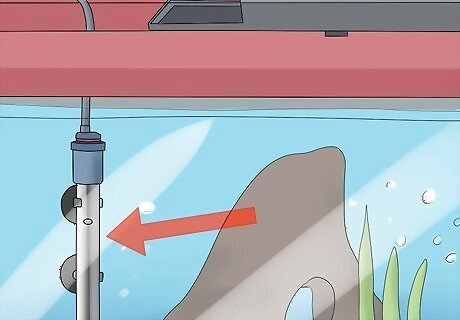
Install a heater-stat. The heater-stat is a combined heater and thermostat designed to function underwater. The thermostat can be set to a specific temperature and the heater will turn on if the water temperature dips below your setting. The most important factor when choosing a heater-stat is appropriate wattage. Be sure to choose one with high enough wattage to warm the size of aquarium you own, but don’t buy one with so much wattage that it will overheat the tank. The general rule is five watts per gallon.
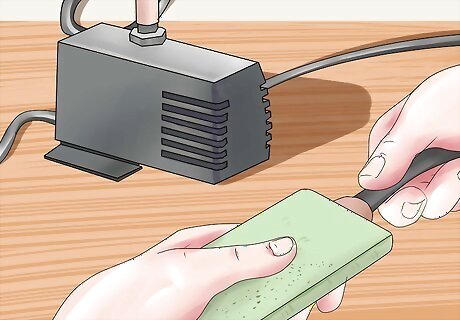
Install an air pump. Air pumps introduce bubbles into the water that will facilitate the exchange of oxygen and carbon dioxide that fish need to breathe. Air pumps are typically optional, as most filtration systems introduce ample oxygen into the water. They can be useful, however, in tanks where large amounts of oxygen is used up by the environment, such as if your tank features a lot of vegetation. Some people opt to use a water pump for the aesthetic value added by the floating bubbles.
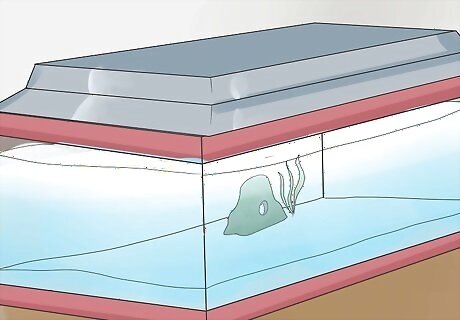
Install a tank light. A tank light will typically be comprised of a starter unit and a tube, and while there are several different types of tank lighting available, fluorescent lighting is the most common choice for new freshwater tank owners. Some saltwater tanks will require more specific lighting setups, determined by the species of fish you have in the tank. Fluorescent tubes are relatively inexpensive to run and don’t produce significant amounts of heat, making them well suited for use in aquariums. Different types of lighting are better suited to encouraging plant growth or enhancing the color of your fish, but generally a full-spectrum light will offer both pleasant lighting and lighting suitable for plants.
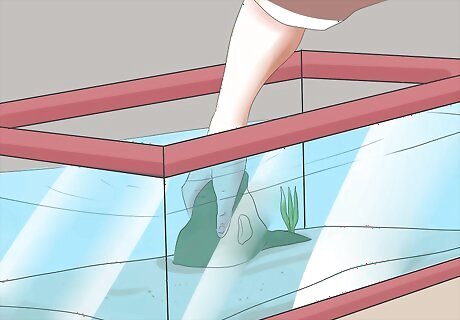
Set up the physical environment. Carefully select which environmental features (rocks, plants, ornaments) you include in your aquarium. The environment must closely emulate the fish’s natural habitat or they will become stressed, sick, and will possibly even die. If you’re unsure of the proper environment for your fish, consult your local fish or aquarium store. If you’re setting up a saltwater aquarium, it’s strongly recommended that you add live rock, which are pieces of coral reef that naturally break or fall off. Live rock contains many live organisms necessary to a healthy tank ecosystem.
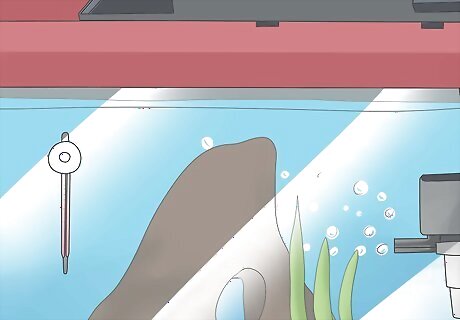
Run the aquarium without any fish. Before introducing any fish to the aquarium, add water and let the pump/filtration system run for three days to a week, which will stabilize the environment and make it hospitable to your new fish. Running the aquarium before putting in any fish is also important because it allows any harmful impurities to dissolve.

Add good bacteria. Introduce good bacteria to the aquarium water with a cycling-aid product, which you can buy from a pet or fish retailer. Good bacteria are a necessary and integral part of your aquarium’s environment. Without them, the delicate ecosystem fish need to survive won’t be able to establish itself.
Introducing Fish to the Aquarium
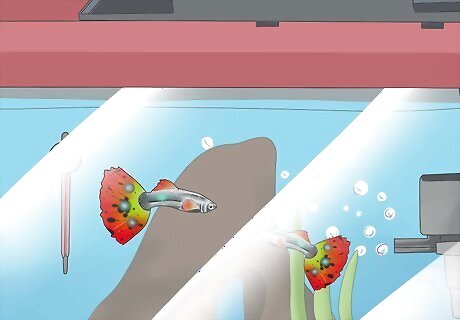
Add resilient fish. When choosing the first few fish you plan to introduce to your aquarium, seek out hardier types. Certain types of fish are better able to survive in an environment with high levels of ammonia and nitrites, which your aquarium will likely have at this point. More resilient fish include danios, gouramis, and livebearers. Don’t add more vulnerable types of fish to this initial tank environment as they likely won’t survive. Ask an employee at the store from which you plan to purchase the fish to help you choose types of fish best suited to a brand-new aquarium. Avoid overcrowding the aquarium. Don’t add more than three fish per week to the tank or you can raise the ammonia in the environment to toxic levels that can kill your fish.

Choose the right fish. As you gradually begin to populate your aquarium, choose your fish very carefully. There are hundreds of kinds of tropical fish, and they don’t all live well together--some are aggressive, some are territorial, some are predatory, and so on. Make sure to choose types of fish that can live together in the tank and won’t fight or kill each other. Choosing the wrong fish not only subjects the fish to unnecessary suffering, it’s also something that’s easily avoidable with a little research. Do your research and consult with an employee at a fish or aquarium retailer so that you know each of your fish’s needs. In addition to making sure your fish will get along, make sure they have compatible living-environment needs. If they all need different kinds of environments to thrive, your ecosystem won’t be able to accommodate those varied needs. In addition to ensuring that your fish have similar habitat needs, be sure the fish also have similar temperature and pH needs.
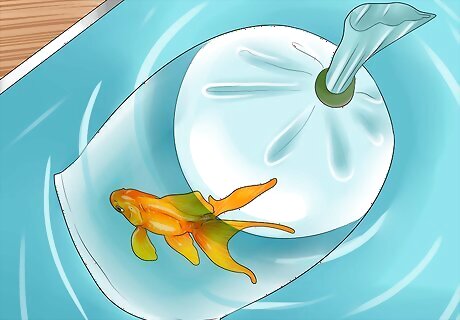
Introduce new fish gradually. Don’t dump a new fish directly into the aquarium. Fish need to be able to regulate their temperature, and being put directly into new water can cause them significant distress. Turn the tank light off so that the bright light won’t disturb the new fish. For freshwater fish, float the plastic bag--still closed--in which you transported your new fish in the tank for about half an hour. Open the bag, put some of the tank water in, and let it sit for at least 15 minutes. Gently net the fish out. Remove the bag once the fish has been removed. Leave the tank light off for another few hours or for the rest of the day. For saltwater fish, you must first quarantine your new fish in a separate tank before introducing it to your aquarium.
Maintaining the Aquarium
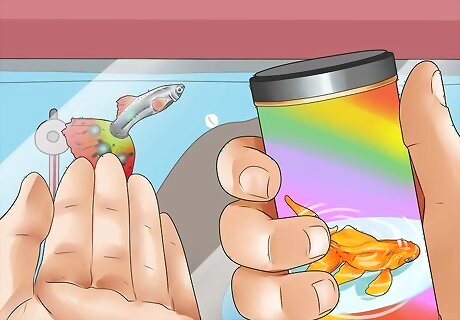
Feed your fish regularly. This isn’t necessarily as simple as it sounds. Initially, feed your fish once a day when first setting up the tank, and once your aquarium is well established, you can begin feeding your fish according to the “little and often” rule. Saltwater fish, particularly if they’re wild-caught, may need to be gradually weaned onto aquarium food over a period of weeks. Some fishkeepers recommend introducing a “rest day” once a week during which no feeding occurs. It’s believed this can benefit your fish's’ health and encourage them to actively look for food. Food is the main source of waste and pollutants in your tank, so it’s crucial you don’t introduce too much, as overfeeding is one of the main reasons aquarium fish die. There's no one-size-fits-all recommendation for feeding, as that is a trial and error process based on your fish. Only feed your fish as much as they can consume in about 30 seconds and no more. Be sure to read the instructions on the fish food label. If food is left floating on the surface or sinks to the bottom, you’re overfeeding. There are three main types of fish food: food for bottom swimmers, middle swimmers, and top swimmers. Be sure to get the right size, quality, and kind of food for your particular fish. It’s generally recommended that you feed your fish a variety of high-quality frozen and pelleted food, and that you make sure to defrost frozen food before feeding.
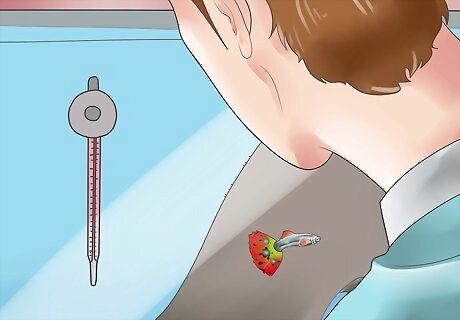
Monitor the temperature everyday. Test the water each day to be sure the water temperature is consistent and in the ideal range for the type of fish in the aquarium. In general, the ideal temperature for freshwater tropical fish is between 74 and 82 degrees Fahrenheit (23-28 degrees Celsius). For saltwater fish, the recommended temperature is usually between 75 and 80 degrees Fahrenheit (24-27 degrees Celsius).
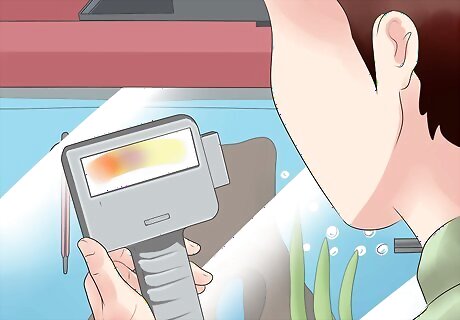
Monitor the water’s composition. Every week, test the water hardness and alkalinity and the levels of ammonia, nitrates, nitrites, pH, and chlorine in your aquarium water. The ideal range of levels for freshwater fish are as follows: pH - 6.5 - 8.2 Chlorine - 0.0 mg/L Ammonia - 0.0 - .25 mg/L Nitrite - 0.0 - 0.5 mg/L Nitrate - 0 - 40 mg/L Hardness - 100 - 250 mg/L Alkalinity - 120 - 300 mg/L Saltwater fish have more specific requirements that will vary by species and that will require additional specialized water-testing kits to check salinity. To find out the specific needs of your saltwater fish, consult with a fish or aquarium retailer. In general, most saltwater fish need the following: Specific gravity: 1.020 - 1.024 mg/L pH: 8.0 - 8.4 Ammonia: 0 mg/L Nitrite: 0 mg/L Nitrate: 20 ppm or less (especially for invertebrates) Carbonate hardness: 7-10 dKH Water testing kits are available from most pet and aquarium retailers. If any of the levels are elevated, remove and replace some of the water until the levels are closer to where they need to be. If the water ever looks cloudy or dirty, replace some of the water and check that your water filter is working properly. For freshwater tanks, remove 10% of the water from the aquarium and replace it with the same amount of dechlorinated water every week. Make sure to add water that’s the same temperature as the water already in the tank or you could cause a temperature fluctuation that will be a stress on your fish. Once a month, remove 25% of the aquarium water and replace it with dechlorinated water. Be careful that the water is the same temperature as that already in the tank or you can cause your fish distress. For saltwater tanks, remove 20% of the water once a month, or about 5% per week. Be sure not to add freshly mixed saltwater directly to the tank; instead, prepare the saltwater mix at least one day before.
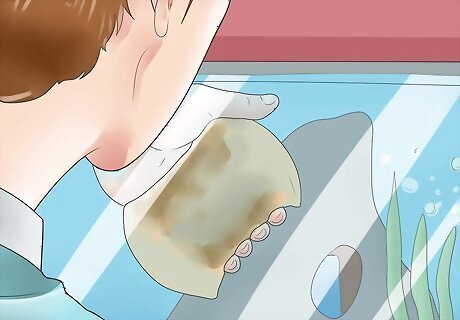
Scrub the walls of the aquarium. Every week, clean the inside tank walls and remove any algae buildup. Choose an acrylic- or glass-specific cleaning pad (according to the material used for your tank’s walls) to avoid scratching the surface. If you have an overabundance of algae, it’s typically a sign that something in your aquarium’s environment isn’t balanced. Test the water levels, be sure you haven’t added too many fish, verify that you aren’t overfeeding, check that the tank isn’t exposed to excessive natural light, etc.
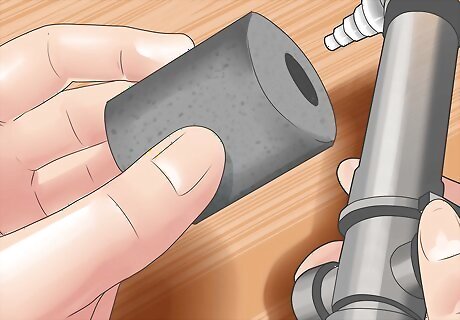
Maintain the water filter. Every month, perform complete water-filter maintenance. Your water filtration system is vital to the maintenance of your aquarium because it removes floating debris and contaminants from the water while neutralizing ammonia and nitrites. Check the filter media (also called the filter floss). If needed, rinse it in some of the discarded tank water. Don’t rinse with tap or other water because it will upset the balance of good bacteria and possibly even kill them off. Replace the carbon, filter cartridge, and pre-rinse filter.
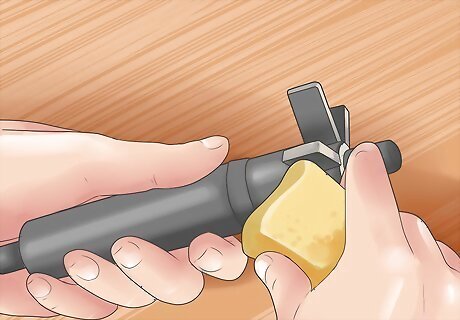
Maintain the water pump. Change the air stone (helps with the water pump’s efficiency and longevity) every month. Clean the pump’s impeller assembly at least once a year.
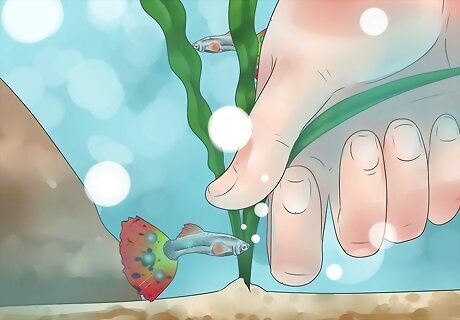
Keep any live plants pruned. If you have live plants in your aquarium, prune them back once a month to prevent them from overgrowing. Also be sure to remove any brown or decaying leaves from your aquarium’s plants.
















Comments
0 comment